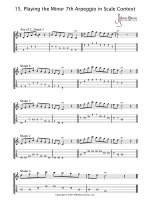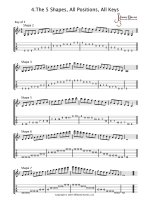Graphics in java with JOGL2 tủ tài liệu bách khoa
Bạn đang xem bản rút gọn của tài liệu. Xem và tải ngay bản đầy đủ của tài liệu tại đây (1.02 MB, 43 trang )
Dr. Manuel Carcenac - European University of Lefke
3D Graphics in Java
with Java Open GL - JOGL 2
Introduction
Installing JOGL on Windows
JOGL connection to Java: JOGL event listener
Geometric transformations:
viewport, projection, viewing transformations
modeling transformation
Geometric modeling with GLU library
Examples with GLU objects and wireframe rendering
Geometric modeling with lines and polygons
Hidden surface removal
Lighting:
lighting model
optical properties of surfaces
light sources
Examples with lighting and surface rendering
References:
/>
(for JOGL 2.0)
/> />
1
Dr. Manuel Carcenac - European University of Lefke
Introduction
step 1: define 3D objects in 3D space
3D graphics:
step 2: rendering with a virtual camera
virtual photographs displayed on a panel of the GUI
sequence of geometric transformations between the panel and the 3D objects:
viewport, projection, viewing, modeling transformations
projection of the 3D objects over the panel
wireframe rendering:
surfaces of objects sketched out with a grid of lines
surface rendering:
surfaces of objects represented realistically:
lighting of the scene
reflection of light over the objects
OpenGL
OpenGL is a state machine
various state variables that keep their values until we change them:
current color
current normal
current projection matrix, modelview matrix
current drawing style
current shading model
.......
OpenGL has a rendering pipeline with several buffers
flushing required to force the execution of all drawing instructions
2
Dr. Manuel Carcenac - European University of Lefke
Java Open GL
event driven system: OpenGL modeling and rendering
are specifed inside the event methods of GLEventListener
double-buffering: one buffer is displayed while the other is being drawn
then, the two buffers are swapped and vice-versa
= allows smooth animation
GLU:
OpenGL Utility Library
provides more elaborate functions than OpenGL:
easy specification of projection and viewing transformations:
gluLookAt
gluPerspective
creation of simple objects: quadric surfaces (cylinders, disks, spheres, ...)
NURBS curves and surfaces
.......
GLUT:
OpenGL Utility Toolkit
toolkit to manage windows and events
we will use Swing and AWT instead.
3
Dr. Manuel Carcenac - European University of Lefke
Installing JOGL on Windows
if not done already, install Java JDK and JRE
for example from files: jdk-6u23-windows-x64.exe
jre-6u23-windows-x64.exe
install JOGL on Windows 64 bits:
download from
/>
open most recent folder
for example:
download
jogl-b******
jogl-b269-2011-01-22_00-21-39/
jogl-2.0-b269-20110122-windows-amd64.zip
( jogl-2.0-b269-20110122-windows-i586.zip for Windows 32 bits)
unzip this file
put the files inside it into the folder C:\JOGL2 on your PC
You now have in C:\JOGL2 the files:
artifact.properties
CHANGELOG.txt
etc
jar
jnlp-files
lib
LICENSE.txt
README.txt
Userguide.html
____VERSION.txt
4
Dr. Manuel Carcenac - European University of Lefke
update system variables:
Computer Properties Advanced system settings Environment Variables
edit system variable Path and add at the end of it:
;C:\Program Files\Java\jdk1.6.0_23\bin;C:\JOGL2\lib
create new system variable CLASSPATH with:
.;C:\JOGL2\jar\jogl.all.jar
;C:\JOGL2\jar\nativewindow.all.jar
;C:\JOGL2\jar\gluegen-rt.jar
;C:\JOGL2\jar\newt.all.jar
compile the java program:
javac
P.java
javac
-O
or
P.java
(optimization)
run the java program:
java
-Dsun.java2d.noddraw=true
import statements:
P
(include them at the beginning of P.java)
import java.awt.*; import java.awt.event.*;
import javax.swing.*; import javax.swing.event.*;
import javax.media.opengl.*; import javax.media.opengl.glu.*;
import javax.media.opengl.fixedfunc.*; import javax.media.opengl.awt.*;
5
Dr. Manuel Carcenac - European University of Lefke
JOGL connection to Java: JOGL event listener
JOGL is event driven:
drawing panel defined as a subclass of GLJPanel
event listener GLEventListener added to the drawing panel
4 event methods defined inside GLEventListener :
init : called only once when JOGL context is initialized
= use it for one-time initialization tasks
reshape : called at the beginning after init and each time the panel (i.e. the frame) is resized
= use it to set the viewport and projection transformations
display : called each time the drawing panel is (re)painted (especially after p.repaint() )
= use it to: set the viewing and modeling transformations
specify the 3D objects that must be displayed
flush the drawing buffer
dispose : called at the end, just before JOGL context is destroyed
= seldom used in practice we will define it with an empty body {}
common argument for these event methods:
GLAutoDrawable drawable
GL2 gl = drawable.getGL().getGL2();
(similar to Graphics g of paintComponent )
(similar to Graphics2D g2 = (Graphics2D)g; )
we will apply most instructions over gl , the others will be applied over glu
(similar to 2D instructions applied over g or g2 )
extra arguments for reshape :
int x , int y , int w , int h
(w×h updated panel size)
6
Dr. Manuel Carcenac - European University of Lefke
template:
class Gui
{
..........
class DrawingPanel extends GLJPanel
{
GLU glu; GLUquadric quad;
to use the GLU library
DrawingPanel()
{ super(new GLCapabilities(GLProfile.getDefault()));
this.addGLEventListener(new GLEventListener()
{
public void init(GLAutoDrawable drawable)
{ GL2 gl = drawable.getGL().getGL2();
define the clearing
gl.glClearColor(1.0f , 1.0f , 1.0f , 0.0f);
color
.......... }
public void reshape(GLAutoDrawable drawable , int x , int y , int w , int h)
{ GL2 gl = drawable.getGL().getGL2();
.......... }
public void display(GLAutoDrawable drawable)
{ GL2 gl = drawable.getGL().getGL2();
gl.glClear(GL.GL_COLOR_BUFFER_BIT);
..........
gl.glFlush(); }
flush the drawing
buffer
public void dispose(GLAutoDrawable drawable)
{}
} );
clear the panel
}
}
Gui()
{
p = new DrawingPanel();
..........
}
}
7
Dr. Manuel Carcenac - European University of Lefke
Geometric transformations
projection
transformation
viewport
transformation
viewing
transformation
screen
camera
coordinate
system
panel
(pixels)
absolute
coordinate
system
modeling
transformation
local
coordinate
system
viewport transformation
inside reshape:
projection transformation
viewing transformation
inside display:
modeling transformation
projection matrix:
projection transformation
modelview matrix:
viewing transformation - modeling transformation
8
Dr. Manuel Carcenac - European University of Lefke
viewport transformation:
gl.glViewport(0 , 0 , w , h);
inside reshape,
specify the width w and height h
of the panel (in pixels)
projection transformation:
glu = new GLU();
inside init,
create glu object
inside reshape,
the current matrix becomes
the projection matrix
gl.glMatrixMode(GLMatrixFunc.GL_PROJECTION);
the current matrix is
set to identity matrix
gl.glLoadIdentity();
glu.gluPerspective(60.0f , (float) w / h , 1.0f , 10000.0f);
the current matrix is multiplied by
matrix expressing perspective:
field of view = angle in degrees= 60
ratio width / height of the panel
minimal distance, maximal distance
objects not within these distances
will be clipped
all arguments of gluPerspective must be of type float
9
Dr. Manuel Carcenac - European University of Lefke
viewing transformation:
geometric transformation from camera coordinate system to absolute coordinate system
camera oriented toward aiming point:
up vector
< UPx , UPy , UPz
>
aiming point
< Ax , Ay , Az >
camera
< Cx , Cy , Cz
>
inside display,
the current matrix becomes
the modelview matrix
gl.glMatrixMode(GLMatrixFunc.GL_MODELVIEW);
gl.glLoadIdentity();
the current matrix is
set to identity matrix
glu.gluLookAt(Cx , Cy , Cz , Ax , Ay , Az , UPx , UPy , UPz);
the current matrix is multiplied by
matrix expressing position
and orientation of camera
all arguments of gluLookAt must be of type float
10
Dr. Manuel Carcenac - European University of Lefke
camera oriented according to roll, pitch, yaw angles:
Figure courtesy
of Wikipedia
inside display,
the current matrix becomes
the modelview matrix
gl.glMatrixMode(GLMatrixFunc.GL_MODELVIEW);
gl.glLoadIdentity();
the current matrix is
set to identity matrix
gl.glRotatef(Croll , 0.0f , 0.0f , 1.0f);
the current matrix is multiplied by
matrix of rotation around local z axis
gl.glRotatef(Cpitch , 1.0f , 0.0f , 0.0f);
the current matrix is multiplied by
matrix of rotation around local x axis
gl.glRotatef(Cyaw , 0.0f , 1.0f , 0.0f);
gl.glTranslatef( - Cx, - Cy, - Cz);
the current matrix is multiplied by
matrix of rotation around local z axis
the current matrix is multiplied by
matrix of translation from camera to
origin of absolute coordinate system
all arguments of glRotatef and glTranslatef must be of type float
11
Dr. Manuel Carcenac - European University of Lefke
modeling transformation:
geometric transformation from absolute coordinate system to each local coordinate system
where some 3D objects
are defined
sequence of translations, rotations and scalings
inside display,
the current matrix becomes
the modelview matrix
gl.glMatrixMode(GL_MODELVIEW);
first, specify the viewing transformation
then, succession of translations,
rotations and scalings:
gl.glTranslatef(delta_x , delta_y , delta_z);
gl.glRotatef(angle in degrees , vx , vy , vz);
gl.glScalef(scale_x , scale_y , scale_z);
rotation around vector following the "corkscrew rule"
12
Dr. Manuel Carcenac - European University of Lefke
modelview matrix stack ; projection matrix stack:
modelview matrix stack
current matrix = top matrix of the current matrix stack
projection matrix stack
(chosen with glMatrixMode)
or
current
matrix
current
stack
previous
matrix
preprevious
matrix
gl.glPushMatrix();
the top matrix
is duplicated
rotations, translations, scalings
applied over the top matrix
gl.glPopMatrix();
the top matrix
is popped off
C
D
D
C
C
C
B
B
B
A
A
A
13
Dr. Manuel Carcenac - European University of Lefke
Geometric modeling with GLU library
inside init :
glu = new GLU();
quad = glu.gluNewQuadric();
some ready-made objects in GLU library:
z
inside display :
glu.gluCylinder(quad , base_radius , top_radius , height
, n_slices , n_loops);
y
x
z
glu.gluSphere(quad , radius
, n_slices , n_loops);
y
x
z
glu.gluDisk(quad , inner_radius , outer_radius
, n_slices , n_loops);
y
x
z
glu.gluPartialDisk(quad , inner , outer
, n_slices , n_loops
, start_angle , sweep_angle);
y
x
n_slices, n_loops define the
wireframe
the grid of facets
that represents the surface
n_slices, n_loops are of type int , other arguments (except quad) are of type float
14
Dr. Manuel Carcenac - European University of Lefke
drawing style:
glu.gluQuadricDrawStyle(quad , style);
GLU.GLU_POINT
or
GLU.GLU_LINE
style =
(wireframe rendering)
or
GLU.GLU_SILHOUETTE
or
GLU.GLU_FILL
(surface rendering)
shading model:
glu.gluQuadricNormals(quad , normal);
GLU.GLU_NONE
or
normal =
GLU.GLU_FLAT
(default)
only for surface rendering
(color constant over each facet)
or
GLU.GLU_SMOOTH
color:
(color interpolated over each facet)
only for surface rendering
0.0f transparent
1.0f opaque
glColor4f(red , green , blue , alpha);
4 float arguments
from 0.0f to 1.0f
15
Dr. Manuel Carcenac - European University of Lefke
template:
class DrawingPanel extends GLJPanel
{
GLU glu; GLUquadric quad;
......
public void init(GLAutoDrawable drawable)
{
......
glu = new GLU();
quad = glu.gluNewQuadric();
glu.gluQuadricDrawStyle(quad , GLU.GLU_LINE);
glu.gluQadricNormals(quad , GLU.GLU_SMOOTH);
......
only for surface rendering
public void display(GLAutoDrawable drawable)
{
..........
glColor4f(1.0f , 0.0f , 0.0f , 1.0f);
glu.gluSphere(quad , 10.0f , 20 , 20);
glColor4f(0.0f , 0.0f , 1.0f , 1.0f);
glu.gluCylinder(quad , 4.0f , 2.0f , 20.0f , 20 , 20);
..........
16
Dr. Manuel Carcenac - European University of Lefke
Examples with GLU objects and wireframe rendering
example 1:
planet and satellite - animation loop - wireframe rendering
17
Dr. Manuel Carcenac - European University of Lefke
example 1:
(continued)
import java.awt.*; import java.awt.event.*;
import javax.swing.*; import javax.swing.event.*;
import javax.media.opengl.*; import javax.media.opengl.glu.*;
import javax.media.opengl.fixedfunc.*; import javax.media.opengl.awt.*;
public class P
{ public static void main(String[] arg)
{ Gui gui = new Gui();
long dt = 100; // 0.1s
while (true)
{
long t_start = System.currentTimeMillis();
gui.alpha += 2.0;
gui.f.repaint();
long dt_real = System.currentTimeMillis() - t_start;
if (dt_real < dt) try {Thread.sleep(dt - dt_real);} catch(InterruptedException e){}
else System.out.println("PC too slow; please increase dt");
}
}
}
class Gui
{
JFrame f; DrawingPanel p;
float dx = 30 , alpha = 0;
class DrawingPanel extends GLJPanel
{
GLU glu; GLUquadric quad;
DrawingPanel()
{
super(new GLCapabilities(GLProfile.getDefault()));
this.addGLEventListener(new GLEventListener()
{
public void init(GLAutoDrawable drawable) //*** INIT
{
GL2 gl = drawable.getGL().getGL2();
glu = new GLU();
quad = glu.gluNewQuadric();
glu.gluQuadricDrawStyle(quad , GLU.GLU_LINE);
gl.glClearColor(1.0f , 1.0f , 1.0f , 0.0f);
}
18
Dr. Manuel Carcenac - European University of Lefke
example 1:
(continued)
public void reshape(GLAutoDrawable drawable , int x , int y , int w , int h)
{
GL2 gl = drawable.getGL().getGL2();
//*** RESHAPE
gl.glViewport(0 , 0 , w , h);
gl.glMatrixMode(GLMatrixFunc.GL_PROJECTION);
gl.glLoadIdentity(); glu.gluPerspective(60.0f , (float) w / h , 1.0f , 10000.0f);
}
public void display(GLAutoDrawable drawable)
{
GL2 gl = drawable.getGL().getGL2();
//*** DISPLAY
gl.glClear(GL.GL_COLOR_BUFFER_BIT);
gl.glMatrixMode(GLMatrixFunc.GL_MODELVIEW);
gl.glLoadIdentity(); glu.gluLookAt(40.0f , 40.0f , 40.0f , 0.0f , 0.0f , 0.0f , 0.0f , 1.0f , 0.0f);
gl.glColor4f(1.0f, 0.0f, 0.0f , 1.0f);
glu.gluSphere(quad , 15.0f , 20 , 20);
gl.glRotatef(alpha , 0.0f , 1.0f , 0.0f);
gl.glColor4f(0.0f, 0.0f, 1.0f , 1.0f);
gl.glTranslatef(dx , 0f , 0f);
glu.gluSphere(quad , 5.0f , 10 , 10);
gl.glFlush();
}
public void dispose(GLAutoDrawable drawable)
{}
} );
//*** DISPOSE
}
}
Gui()
{
f = new JFrame(); f.setFocusable(true); f.setVisible(true);
p = new DrawingPanel(); f.getContentPane().add(p , BorderLayout.CENTER);
f.setSize(new Dimension(400 + 16 , 400 + 38));
}
}
19
Dr. Manuel Carcenac - European University of Lefke
example 2:
head with hat - roll, pitch, yaw camera orientation
20
Dr. Manuel Carcenac - European University of Lefke
example 2:
(continued)
class Gui
{
JFrame f;
DrawingPanel p;
float Cx =80, Cy = 80, Cz = 80, Croll = 0 , Cpitch = 45 , Cyaw = -45;
JPanel psC; JSlider sCx , sCy , sCz , sCroll , sCpitch , sCyaw;
class DrawingPanel extends GLJPanel
{
GLU glu; GLUquadric quad;
DrawingPanel()
{
super(new GLCapabilities(GLProfile.getDefault()));
this.addGLEventListener(new GLEventListener()
{
public void init(GLAutoDrawable drawable) //*** INIT
{
GL2 gl = drawable.getGL().getGL2();
glu = new GLU(); quad = glu.gluNewQuadric();
glu.gluQuadricDrawStyle(quad , GLU.GLU_LINE);
gl.glClearColor(1.0f , 1.0f , 1.0f , 0.0f);
}
public void reshape(GLAutoDrawable drawable , int x , int y , int w , int h)
{
GL2 gl = drawable.getGL().getGL2();
//*** RESHAPE
gl.glViewport(0 , 0 , w , h);
gl.glMatrixMode(GLMatrixFunc.GL_PROJECTION);
gl.glLoadIdentity(); glu.gluPerspective(60.0f , (float) w / h , 1.0f , 10000.0f);
}
21
Dr. Manuel Carcenac - European University of Lefke
example 2:
(continued)
public void display(GLAutoDrawable drawable)
{
GL2 gl = drawable.getGL().getGL2();
//*** DISPLAY
gl.glClear(GL.GL_COLOR_BUFFER_BIT);
gl.glMatrixMode(GLMatrixFunc.GL_MODELVIEW);
gl.glLoadIdentity();
gl.glRotatef(Croll , 0.0f , 0.0f , 1.0f);
gl.glRotatef(Cpitch , 1.0f , 0.0f , 0.0f);
gl.glRotatef(Cyaw , 0.0f , 1.0f , 0.0f);
gl.glTranslatef( - Cx, - Cy, - Cz);
gl.glColor4f(1.0f, 0.0f, 0.0f , 1.0f);
//// CAMERA
//// HEAD
glu.gluSphere(quad , 30.0f , 15 , 15);
gl.glPushMatrix(); gl.glTranslatef(0.0f , 0.0f , 30.0f);
glu.gluCylinder(quad , 5.0f , 0.0f , 15.0f , 10 , 10); gl.glPopMatrix();
gl.glPushMatrix(); gl.glTranslatef(30.0f , 0.0f , 0.0f);
glu.gluPartialDisk(quad , 0.0f , 10.0f , 10 , 10 , 0.0f , +180.0f);
gl.glPopMatrix();
gl.glPushMatrix(); gl.glTranslatef(-30.0f , 0.0f , 0.0f);
glu.gluPartialDisk(quad , 0.0f , 10.0f , 10 , 10 , 0.0f , -180.0f);
gl.glPopMatrix();
gl.glColor4f(0.0f, 0.0f, 1.0f , 1.0f);
//// HAT
gl.glPushMatrix(); gl.glTranslatef(0.0f , 30.0f , 0.0f);
glu.gluDisk(quad , 10.0f , 25.0f , 10 , 10);
glu.gluCylinder(quad , 10.0f , 10.0f , 10.0f , 10 , 10);
gl.glRotatef(-90.0f , 1.0f , 0.0f , 0.0f);
gl.glPushMatrix(); gl.glTranslatef(0.0f , 0.0f , 10.0f);
glu.gluDisk(quad , 0.0f , 10.0f , 10 , 10); gl.glPopMatrix();
gl.glPopMatrix();
gl.glFlush();
}
public void dispose(GLAutoDrawable drawable)
{}
} );
//*** DISPOSE
}
}
22
Dr. Manuel Carcenac - European University of Lefke
example 2:
(continued)
Gui()
{
f = new JFrame(); f.setFocusable(true); f.setVisible(true);
p = new DrawingPanel(); f.getContentPane().add(p , BorderLayout.CENTER);
////------------------------ CAMERA
psC = new JPanel(); psC.setLayout(new GridLayout(0 , 1));
f.getContentPane().add(psC , BorderLayout.EAST);
sCx = new JSlider(JSlider.HORIZONTAL , -200 , +200 , 80); psC.add(sCx);
sCy = new JSlider(JSlider.HORIZONTAL , -200 , +200 , 80); psC.add(sCy);
sCz = new JSlider(JSlider.HORIZONTAL , -200 , +200 , 80); psC.add(sCz);
sCroll = new JSlider(JSlider.HORIZONTAL , -180 , +180 , 0); psC.add(sCroll);
sCpitch = new JSlider(JSlider.HORIZONTAL , -270 , +90 , 45); psC.add(sCpitch);
sCyaw = new JSlider(JSlider.HORIZONTAL , -180 , +180 , -45); psC.add(sCyaw);
sCx.addChangeListener( . . . . . . . . { Cx = sCx.getValue(); f.repaint(); } } );
sCy.addChangeListener( . . . . . . . . { Cy = sCy.getValue(); f.repaint(); } } );
sCz.addChangeListener( . . . . . . . . { Cz = sCz.getValue(); f.repaint(); } } );
sCroll.addChangeListener( . . . . . . . . { Croll = sCroll.getValue();
f.repaint(); } } );
sCpitch.addChangeListener( . . . . . . . . { Cpitch = sCpitch.getValue(); f.repaint(); } } );
sCyaw.addChangeListener( . . . . . . . . { Cyaw = sCyaw.getValue(); f.repaint(); } } );
f.setSize(new Dimension(800 + 16 , 400 + 38));
}
}
23
Dr. Manuel Carcenac - European University of Lefke
example 3:
robotic arm - roll, pitch, yaw camera orientation
24
Dr. Manuel Carcenac - European University of Lefke
example 3:
(continued)
class Gui
{
JFrame f;
DrawingPanel p;
float Cx =260, Cy = 260, Cz = 260, Croll = 0 , Cpitch = 45 , Cyaw = -45;
JPanel psC; JSlider sCx , sCy , sCz , sCroll , sCpitch , sCyaw;
float a_ = 0 , a0 = 0 , a1 = 0 , a2 = 0 , a3 = 0 , a4 = 0 , a5 = 0;
float b0 = 110 , b1 = 90 , b2 = 30 , b3 = 20 , b4 = 30 , b5 = 20;
float r0 = 16 , r1 = 10 , r2 = 6 , r3 = 4 , r4 = 6 , r5 = 4;
JPanel ps; JSlider sa_ , sa0 , sa1 , sa2 , sa3 , sa4 , sa5;
class DrawingPanel extends GLJPanel
{
GLU glu; GLUquadric quad;
DrawingPanel()
{
super(new GLCapabilities(GLProfile.getDefault()));
this.addGLEventListener(new GLEventListener()
{
public void init(GLAutoDrawable drawable) //*** INIT
{
GL2 gl = drawable.getGL().getGL2();
glu = new GLU(); quad = glu.gluNewQuadric();
glu.gluQuadricDrawStyle(quad , GLU.GLU_LINE);
gl.glClearColor(1.0f , 1.0f , 1.0f , 0.0f);
}
public void reshape(GLAutoDrawable drawable , int x , int y , int w , int h)
{
GL2 gl = drawable.getGL().getGL2();
//*** RESHAPE
gl.glViewport(0 , 0 , w , h);
gl.glMatrixMode(GLMatrixFunc.GL_PROJECTION);
gl.glLoadIdentity(); glu.gluPerspective(60.0f , (float) w / h , 1.0f , 10000.0f);
}
25









